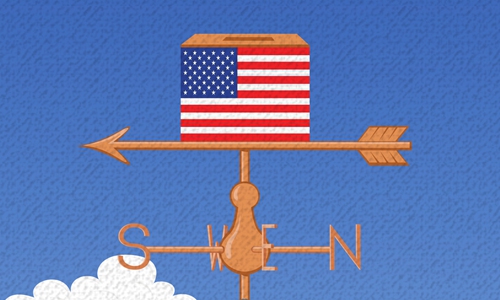HOME >> OPINION
Young US adults' concerns may affect presidential election
By Ling Shengli Source:Global Times Published: 2019/12/4 22:18:40

Illustration: Liu Rui/GT
Socialism is as popular as capitalism among young adults in the US, according to a survey by Gallup, a US-based polling organization. Forty-nine percent of Americans aged 18 to 39 view socialism positively while it is 51 percent for capitalism. This seems inconceivable. But given that the Gallup poll was mainly about respondents' views in economic fields, the attitudes actually reflect Americans' pragmatism and the return of individualism. Hence, the candidates vying for the presidency should pay more attention to social issues like the wealth gap.As the bellwether of capitalist countries, the US has been very confident about its liberal democracy and takes it as the foundation from which all its power emanates. Washington has also been dedicated to promoting its liberal democratic model. However, repeated domestic problems have exposed the flaws of the US system.
In the political sphere, democracy hasn't worked well in the US. US President Donald Trump, once a political nobody, blew away political elites by winning the presidential election. Economically, the middle and lower classes are becoming increasingly dissatisfied as the wealth gap is widening. In addition, populism is thriving in the US. Americans are concerned by the worsening split in society and fiercer infighting among political parties: both Democrats and Republicans are only busy figuring out a way to gain more votes in the presidential election in 2020.
Trump assuming office was a body blow to the establishment camp. US political elites and mainstream media used to pay more attention to the appeals of middle and upper classes, but Trump, who has been to some extent representing the demands of white men from the middle and lower classes, was elected. The latter group cares more about individual or family financial situation rather than the country's international responsibility or values. This is why the "America First" policy can get sustained support. The Gallup survey has further reflected that individualism has the upper hand and thus to some extent pushes forward populism in the US.
Since the founding of the US, individualism has been the impetus for the country's innovation and liberalism. US political system is designed to limit public power and show the supremacy of individualism. The skewed distribution of household wealth has triggered various social and political problems in the US with tardy progress in implementing welfare measures for the middle and lower classes.
The richest 10 percent of US households represented 70 percent of all US wealth in 2018, compared with 60 percent in 1989. In 2016, the richest 1 percent of households held more than half of all outstanding stock, financial securities, trust equity, and business equity, and 40 percent of non-home real estate. And the richest 10 percent of households controlled 93 percent share of directly owned stocks and mutual funds. In the meantime, the bottom 90 percent of households was responsible for 72 percent of total indebtedness.
The wealth gap will inevitably affect the ethos and political ecology of the US. The US poor believe the wealth gap is a result of an unfair distribution system and capitalism is in favor of magnates. On the contrary, they think socialism can somewhat limit crony capitalism and lead to fairer distribution of household wealth and improve the poor's economic welfare.
For US election candidates, their approval ratings will decide their political career. Amid a surge of populism, anyone who wants to win the election needs to take ethos into consideration. Americans, particularly the young, have shown their concerns about living standards by viewing socialism positively. As social classes solidify, young Americans wish to have a better future, and this is why younger adults have shown increasingly positive attitudes toward socialism since 2010.
In recent years, young Americans have been more proactive in politics. About 28.2 percent of young Americans aged 18 to 29 voted in the 2018 midterm elections - more than double the national youth turnout in the 2014 midterms. The turnout of Americans aged 30 to 44 was about 49 percent in the 2018 midterm elections, up by 13 percent compared to 2014.
Due to the higher turnout among 18 to 29-year-olds and 30 to 44-year-olds, the percentage of voters under the age of 45 rose to 35.4 in 2018, up from just 30.3 percent in 2014, according to the Brookings Institution. Young people have gradually become the main voters in US presidential elections. Therefore, for any candidate, to listen to what young people want will be increasingly important.
The author is secretary-general of the International Security Study Center at China Foreign Affairs University. opinion@globaltimes.com.cn
Posted in: VIEWPOINT